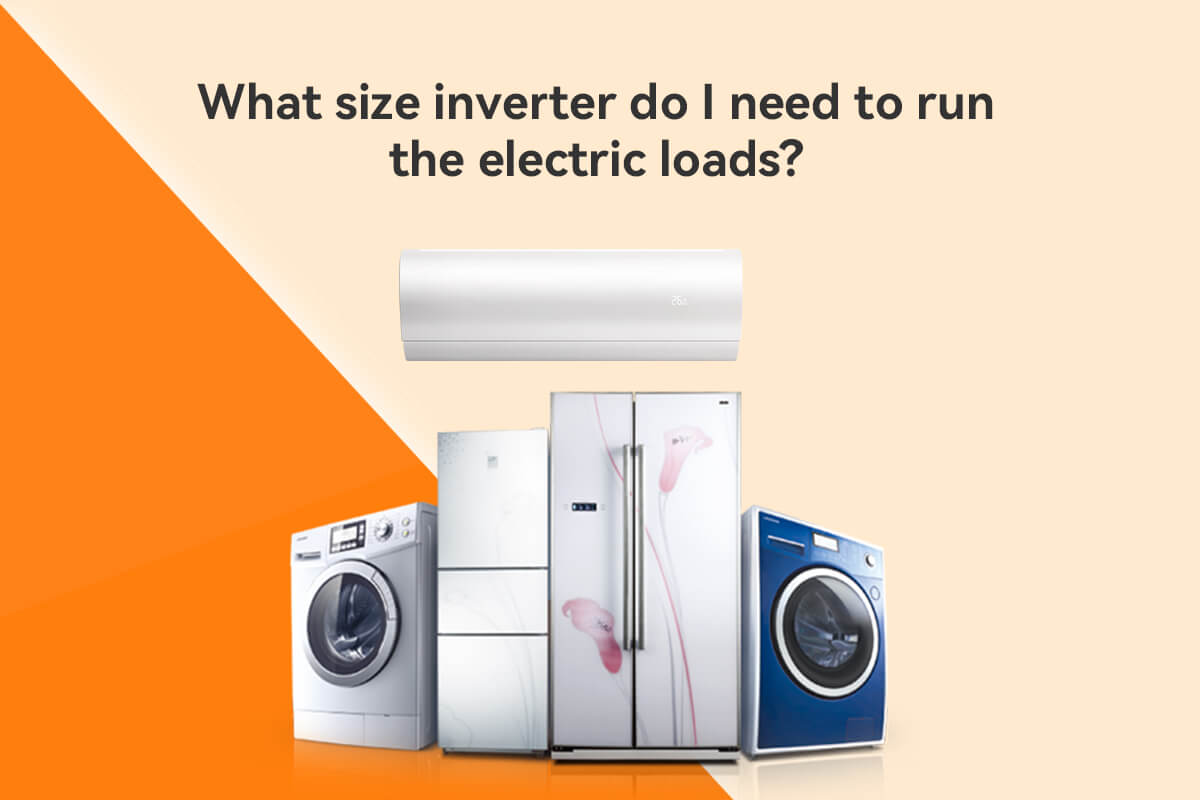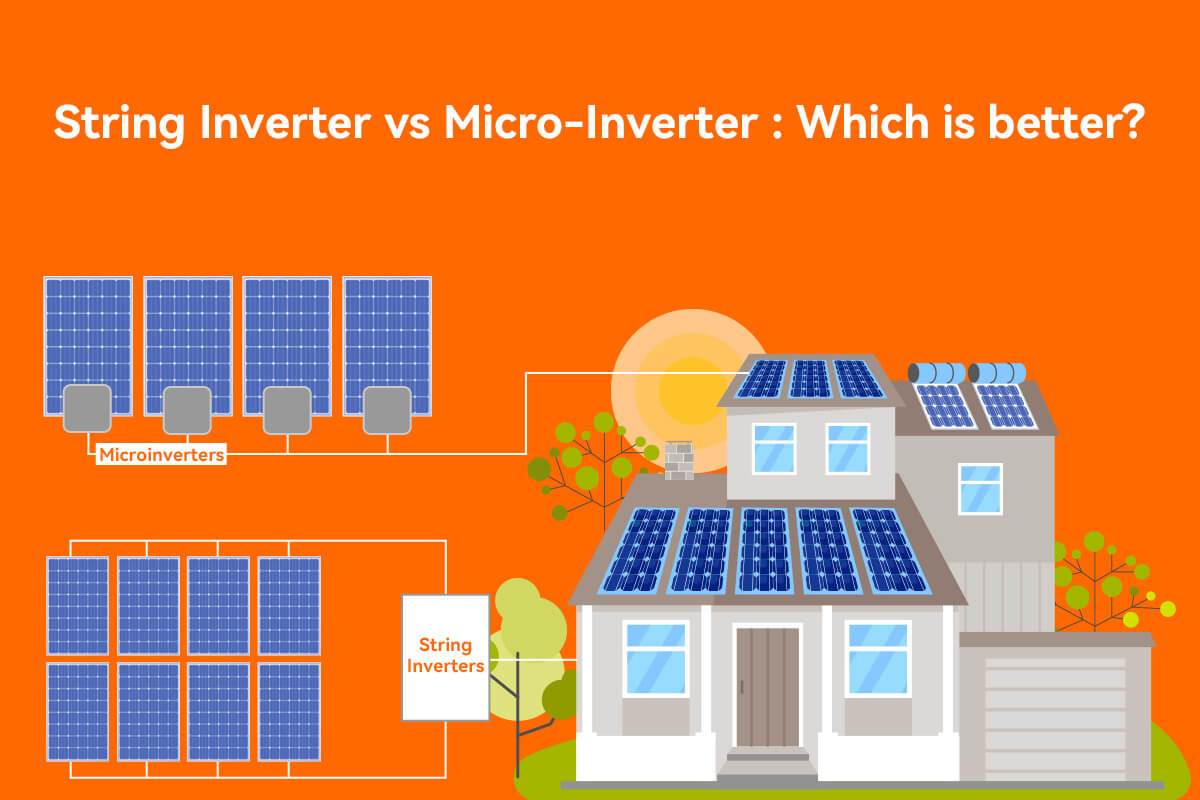อินเวอร์เตอร์เก็บพลังงานแสงอาทิตย์เป็นหัวใจของระบบพลังงาน PV แผงโซลาร์เซลล์ แบตเตอรี่ และกริดต้องพึ่งพามันในการแปลงพลังงาน DC เป็นพลังงาน AC เพื่อจ่ายพลังงานให้กับอุปกรณ์ ซึ่งหมายความว่า อินเวอร์เตอร์มีหน้าที่ในการให้พลังงานกับโหลด ดังนั้น โหลดจึงเป็นหนึ่งใน ปัจจัยที่สำคัญ ในการกำหนดสเปคของระบบเก็บพลังงานแสงอาทิตย์ทั้งหมด และผู้บริโภคควรมีความเข้าใจเบื้องต้นเกี่ยวกับคุณสมบัติของโหลดก่อนที่จะซื้ออินเวอร์เตอร์.
ประเภทของโหลดไฟฟ้า
ที่นี่เราจะแนะนำแนวคิดเกี่ยวกับประเภทของโหลดสามประเภทในระบบพลังงานก่อนเป็นอันดับแรก
โหลดเหนี่ยวนำคืออะไร?
โหลดเหนี่ยวนำมักจะหมายถึงอุปกรณ์ไฟฟ้าที่ มีส่วนประกอบที่มีขดลวด ซึ่งต้องการสร้างสนามแม่เหล็กเพื่อทำงานได้อย่างมีประสิทธิภาพ ตัวอย่างในชีวิตประจำวัน ได้แก่ พัดลมไฟฟ้า เตาแม่เหล็กไฟฟ้า เครื่องปรับอากาศ เครื่องผสม ปั๊ม หม้อแปลง มอเตอร์ ฯลฯ เนื่องจากการเหนี่ยวนำแม่เหล็กไฟฟ้า การเปลี่ยนแปลงของกระแสไฟฟ้าจะถูกต้านทานและกระแสไฟฟ้าที่ไหลผ่านวงจรจะล่าช้ากว่าความดันโหลดโดยมีความแตกต่างของเฟสหนึ่งเฟส.
โหลดต้านทานคืออะไร?
ในภาษาที่เข้าใจง่าย ในวงจร อุปกรณ์ไฟฟ้าที่กระแสไฟฟ้าไหลผ่านเฉพาะองค์ประกอบที่มีความต้านทานในวงจรเรียกว่าโหลดที่มีความต้านทาน ตัวอย่างทั่วไปได้แก่ หลอดไฟฟ้าแบบไส้ และเตาไฟฟ้า เป็นต้น องค์ประกอบที่มีความต้านทานเหล่านี้ทำงานเมื่อแรงดันไฟฟ้าและกระแสไฟฟ้าอยู่ในเฟสเดียวกัน นั่นคือ ความแตกต่างของเฟสเท่ากับ 0.
โหลดแบบความจุคืออะไร?
โหลดแบบ capacitive โดยทั่วไปคืออุปกรณ์ที่กระแสโหลดเกินแรงดันไฟฟ้าด้วยความแตกต่างของเฟสหนึ่ง แต่โดยปกติแล้วส่วนประกอบแบบ capacitive จะไม่มีอยู่โดยอิสระในอุปกรณ์ไฟฟ้า.
ทำไมโหลดเหนี่ยวนำถึงสำคัญ?
กำลังไฟที่ระบุของโหลดที่เชื่อมต่อกับระบบควรถูกคำนวณและตรวจสอบก่อนที่จะซื้ออินเวอร์เตอร์ กำลังไฟขาออกของอินเวอร์เตอร์ที่ใช้ควรถูกกำหนดตามกำลังไฟรวมของโหลด โดยคำนึงถึงผลกระทบและความต้องการที่อาจเกิดขึ้นกับอินเวอร์เตอร์จาก กำลังไฟกระชาก และกำลังไฟรีแอคทีฟที่ต้องการโดยโหลดพิเศษบางประเภทในระหว่างการเริ่มต้น และต้องมั่นใจว่าความจุของอินเวอร์เตอร์มีขนาดใหญ่พอ
พลังที่แท้จริงคืออะไร?
ในวงจร AC พลังงานที่ใช้งานได้คือส่วนหนึ่งของพลังงานที่ถูกใช้ในองค์ประกอบที่มีความต้านทานและ ไม่สามารถกลับคืนได้ เช่น เป็นความร้อน แสงสว่าง หรือพลังงานกล.
พลังงานรีแอกทีฟคืออะไร?
ในระบบไฟฟ้า คล้ายกับส่วนประกอบเหนี่ยวนำที่ประกอบด้วยขดลวดและแม่เหล็กซึ่งต้องสร้างสนามแม่เหล็กเพื่อทำงาน พลังงานที่ใช้ในการสร้างสนามไฟฟ้าจะเรียกว่า พลังงานรีแอคทีฟ ในกระบวนการแปลงระหว่างพลังงานไฟฟ้าและพลังงานแม่เหล็ก พลังงานแม่เหล็กบางส่วนจะ กลับคืนสู่พลังงานไฟฟ้า และไม่มีพลังงานถูกใช้.
พลังงานที่เห็นได้ชัดคืออะไร?
กำลังไฟฟ้ารวม ที่สามารถ จ่ายโดยแหล่งจ่ายไฟ AC เรียกว่ากำลังไฟฟ้าสัมพัทธ์ ในเชิงตัวเลขคือผลคูณของแรงดันไฟฟ้าและกระแสไฟฟ้า ในหน่วย VA กำลังไฟฟ้าสัมพัทธ์คือความสามารถของแหล่งจ่ายไฟ AC.
ในระบบพลังงาน ประเภทของโหลดสามประเภทที่แนะนำในตอนต้นของบทความมักจะมีอยู่พร้อมกัน โหลดเหนี่ยวนำเป็นที่พบได้ทั่วไป แต่ สัดส่วนของพวกมันจะแตกต่างกันในระบบที่หลากหลาย ระบบพลังงานจะมีลักษณะเป็นโหลดเหนี่ยวนำหรือโหลดเก็บประจุตามลำดับ ภายใต้สภาวะปกติ อุปกรณ์จะได้รับพลังงานไม่เพียงแต่พลังงานจริง แต่ยังรวมถึงพลังงานรีแอกทีฟจากแหล่งจ่ายพลังงานด้วย.
แม้ว่าพลังงานรีแอกทีฟจะถูกถ่ายโอนไปมาระหว่างแหล่งจ่ายไฟและโหลดโดยไม่ถูกใช้ แต่โหลดส่วนใหญ่ในระบบพลังงานเป็นโหลดเหนี่ยวนำ หากพลังงานรีแอกทีฟที่จ่ายโดยอินเวอร์เตอร์ไม่เพียงพอ เมื่อโหลดเหนี่ยวนำทั้งหมดเริ่มทำงานพร้อมกัน พวกเขาจะไม่มีพลังงานรีแอกทีฟเพียงพอในการสร้างสนามแม่เหล็กไฟฟ้าปกติ และอุปกรณ์ไฟฟ้าเหล่านี้ไม่สามารถทำงานภายใต้สภาวะที่กำหนดได้.
หลักการชดเชยกำลังรีแอกทีฟ
ในวงจร AC กระแสในโหลดที่มีความต้านทานบริสุทธิ์จะอยู่ในเฟสเดียวกับแรงดันไฟฟ้า กระแสในโหลดที่มีความเหนี่ยวนำบริสุทธิ์จะล่าช้าเมื่อเปรียบเทียบกับแรงดันไฟฟ้า และกระแสในโหลดที่มีความจุบริสุทธิ์จะนำหน้าแรงดันไฟฟ้า กล่าวอีกนัยหนึ่ง ความแตกต่างของเฟส ระหว่างกระแสในความเหนี่ยวนำบริสุทธิ์และความจุบริสุทธิ์ สามารถยกเลิกกันได้.
หลักการพื้นฐานของการชดเชยพลังงานรีแอกทีฟคือการ เชื่อมต่ออุปกรณ์ที่มีโหลดแบบเก็บประจุและโหลดแบบเหนี่ยวนำขนานกันในวงจรเดียวกัน เมื่อโหลดแบบเก็บประจุปล่อยพลังงาน โหลดแบบเหนี่ยวนำจะดูดซับพลังงาน; ขณะที่โหลดแบบเหนี่ยวนำปล่อยพลังงาน โหลดแบบเก็บประจุจะดูดซับพลังงาน และพลังงานจะถูกแลกเปลี่ยนระหว่างโหลดทั้งสอง.
ด้วยวิธีนี้ พลังงานรีแอคทีฟที่ถูกดูดซับโดยโหลดเหนี่ยวนำสามารถถูกชดเชยด้วยพลังงานรีแอคทีฟที่ออกจากโหลดตัวเก็บประจุ ซึ่งเป็นหลักการพื้นฐานของการชดเชยพลังงานรีแอคทีฟ.
วิธีการเลือกอินเวอร์เตอร์ที่ตรงกับโหลดเหนี่ยวนำ
ปัจจัยกำลังคืออะไร?
ปัจจัยกำลังเป็นการวัดประสิทธิภาพพลังงานที่ใช้ในการทำงานของเครื่องจักรและอุปกรณ์ในช่วงระยะเวลาหนึ่ง และค่าของมันคือ อัตราส่วนของกำลังจริงต่อกำลังปรากฏ.
ด้วย เครื่องวิเคราะห์พลังงาน คุณสามารถวัดพลังงานที่ใช้งาน (kW) และพลังงานที่ปรากฏ (kVA) ของโหลด และจึงคำนวณค่าอัตราส่วนพลังงาน.
-
PF = (พลังงานจริง)/(พลังงานที่ปรากฏ)
เมื่ออุปกรณ์ไฟฟ้าเป็น โหลดที่มีความต้านทานล้วนหรือค่าแรงดันไฟฟ้ามากกว่า 0.9 กำลังไฟที่ระบุของอินเวอร์เตอร์จะถูกเลือกให้ มีค่า 1.1 ถึง 1.15 เท่า ของความจุของมัน.
ไฟกระชากคืออะไร?
การเพิ่มขึ้นคือการเพิ่มแรงดันไฟฟ้าที่เกิดจากโหลดที่มีความจุซึ่งจะดูดซับกระแสไฟฟ้าบางส่วนเมื่ออุปกรณ์อิเล็กทรอนิกส์ถูกเปิดในระบบไฟฟ้า。ความสามารถในการเพิ่มขึ้นของอินเวอร์เตอร์ (โดยทั่วไปจะเป็นสองเท่าของกำลังไฟที่ระบุของอินเวอร์เตอร์) เป็นพารามิเตอร์ที่คุณต้องทราบก่อนที่จะซื้ออินเวอร์เตอร์ เพราะเมื่อแรงดันไฟฟ้าของวงจรเกินขอบเขตนี้ องค์ประกอบอิเล็กทรอนิกส์ของอุปกรณ์อาจเสียหายได้.
แรงดันไฟฟ้าชั่วคราวคืออะไร?
การเปลี่ยนแปลงชั่วคราวเกิดจากการเพิ่มขึ้นอย่างรวดเร็วของแรงดันไฟฟ้าหรือกระแสไฟฟ้าเนื่องจาก การปล่อยพลังงานที่เก็บไว้ในโหลดเหนี่ยวนำ การเปลี่ยนแปลงชั่วคราวแตกต่างจากการเพิ่มขึ้นเพราะมัน ทำให้เกิดความเสียหายมากกว่าและมีระยะเวลานานกว่า การระเบิดของพลังงานเหล่านี้สามารถทำให้เกิดความเสียหายต่ออินเวอร์เตอร์หรือแม้แต่เครื่องมืออื่น ๆ ได้.
ดังนั้น เพื่อหลีกเลี่ยงความล้มเหลวเช่นนี้ ผู้บริโภคควรตรวจสอบให้แน่ใจว่ากำลังไฟของอินเวอร์เตอร์ที่เลือกนั้น มากกว่าหรือเท่ากับกำลังไฟสูงสุดของโหลดเหนี่ยวนำ โดยทั่วไปแล้ว กำลังไฟสูงสุดของโหลดเหนี่ยวนำจะอยู่ที่ 3 ถึง 9 เท่าของกำลังไฟตามมาตรฐาน.
สมมติว่าคุณต้องการซื้ออินเวอร์เตอร์ที่สามารถส่งออกพลังงานได้ทันที 2 เท่าของพลังงานที่ระบุ และโหลดที่เป็นตัวเก็บประจุหรือเหนี่ยวนำที่จะขับมีพลังงานที่ระบุอยู่ที่ 1000w ซึ่งหมายความว่ามีพลังงานสูงสุดที่ 9000w พลังงานสูงสุดนี้หารด้วยสองจะเป็นพลังงานที่ระบุของอินเวอร์เตอร์ที่ต้องการ นั่นคือ 4500w.
ถ้ากำลังของอินเวอร์เตอร์น้อยกว่าค่านี้ จะต้องเชื่อมต่ออินเวอร์เตอร์สองตัวขึ้นไปแบบขนานเพื่อให้มีกำลังเพียงพอสำหรับโหลด.



